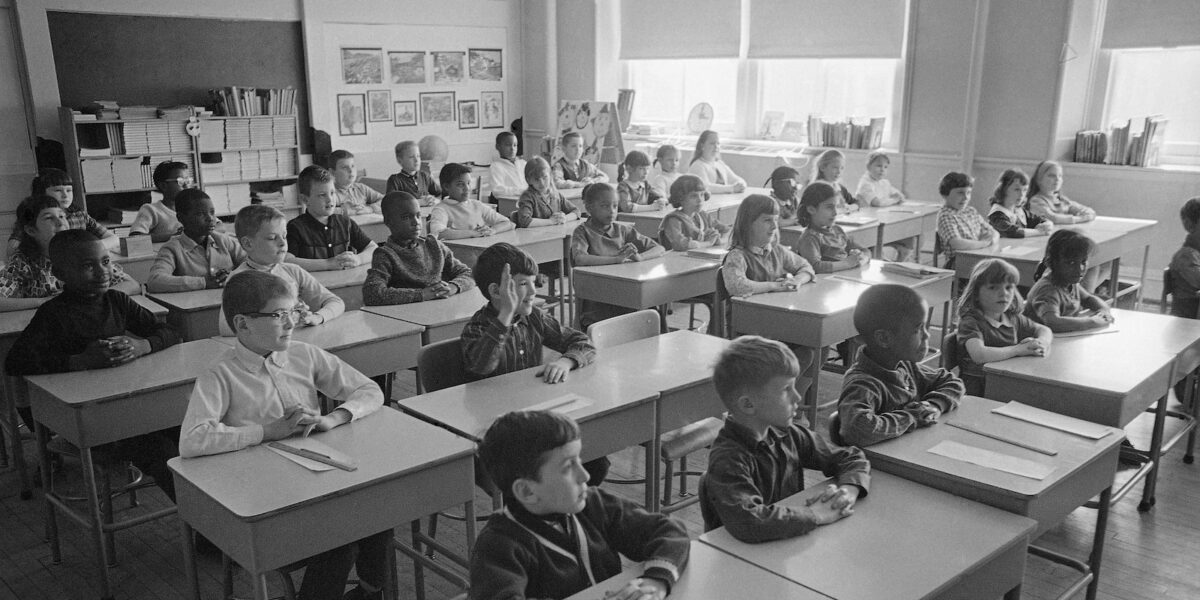On May 17, 1954, the Supreme Court laid out a new precedent: Separate but equal has no place in American schools.
The message of Brown v. Board of Education was clear. But 70 years later, the impact of the decision is still up for debate. Have Americans truly ended segregation in fact, not just in law?
The answer is complicated. U.S. schools in recent decades have grown far more diverse and, by some measures, more segregated, according to an Associated Press analysis.
On one hand, the number of Black and white students who go to school almost exclusively with students of the same race is at an all-time low.
On the other hand, huge shares of students of color still go to schools with almost no white students. Hispanic segregation is worse now than in the 1960s. The nation’s largest school districts, in particular, have seen a surge in segregation since the 1990s, according to research from Stanford University’s Educational Opportunity Project.
The history of school desegregation efforts, from Brown v. Board to today, shows how far the U.S. has come – and how far it has to go.
The Brown v. Board decision declared white and Black students could not be forced to attend separate schools, even if those schools were allegedly equal in quality.
A few states such as Kansas and Delaware made some effort to comply with the order. But leaders in the Deep South immediately declared what U.S. Sen. Harry Byrd of Virginia called ” massive resistance ″ to integration.
In all, segregation levels changed little over the next decade, despite the bravery of Black students like the Little Rock Nine in 1957 and 6-year-old Ruby Bridges in New Orleans in 1960, who faced violent, racist mobs when they tried to desegregate their local schools.
By the mid-1960s, the federal courts lost patience with the South. They started to mete out desegregation orders with teeth, requiring busing if necessary. Supreme Court Justice William J. Brennan Jr. declared segregation must be ripped out “root and branch.”
At the same time, civil rights legislation of the 1960s reshaped schools in far-reaching ways. The Civil Rights Act of 1964 banned discrimination in education; the Voting Rights Act gave Black voters more power to choose school boards; and the Elementary and Secondary Education Act offered schools federal cash if they desegregated. Meanwhile, the Immigration and Nationality Act opened the country to more immigrants from Asia, Africa and Latin America, leading to far more diverse schools.
From there, segregation decreased quickly. Almost every Black student in the South went to school only with people of color in 1963; only one-fourth of Black students did in 1968.
But desegregation came with a price: Thousands of qualified Black teachers were laid off, even though they were often more credentialed and qualified than white teachers.
“Integration has never been equitable,” said Ivory Toldson, a professor at Howard University.
Courts also began pushing desegregation in other parts of the country. Denver was one of the first cities outside the South called out for segregation in a 1973 Supreme Court case. Places like San Francisco and Cleveland were subject to desegregation orders, and riots broke out in 1974 over busing orders in Boston.
The momentum was short-lived. In 1974, the Supreme Court in Milliken v. Bradley struck down a desegregation plan that involved multiple school districts in and around Detroit. That meant metropolitan areas, with rare exceptions, could not be forced to bus students across school district lines.
The era saw massive white flight from urban school districts, in places where busing was required and where it was not. Los Angeles, Chicago and New York City collectively lost over half a million white public school students from 1968 to 1980. In just twelve years, the number of white students fell 71% in New Orleans, 78% in Detroit and 86% in Atlanta.
Still, federal court orders had succeeded in reducing Black segregation to its lowest level ever by 1986.
After that, progress began to stall.
The courts gradually began to focus less on achieving racially balanced schools and more on other ways to promote desegregation, such as magnet schools. It became easier for school districts to argue they had made enough progress to be released from desegregation orders, and most of them were lifted by the early 2000s. A few hundred are still active today, but usually unenforced; school district leaders often don’t know they’re still under desegregation orders.
The segregation of Black students changed little after the 1980s. As Latino immigration soared, so did the segregation of Latino students.
The effects of isolation are particularly pernicious for students who come from an immigrant background, said Patricia Gándara, co-director of UCLA’s Civil Rights Project. These families are less likely to speak English or know the unspoken rules of the American education system, like how to apply for college.
More court cases chipped away at policy tools to address desegregation, turning toward the conservative idea that setting targets by race is itself a form of racial discrimination.
Nevertheless, classrooms became more diverse, reflecting the country’s changing demographics. A historic milestone came in 2014, when for the first time the majority of U.S. students were children of color.
Students of color may be more exposed to each other, but they’re still often in separate schools from white students. Around 4 out of 10 Black and Hispanic students go to schools made up almost entirely of other students of color.
Racial imbalance is particularly acute in the nation’s 100 largest districts, according to researchers from Stanford’s Educational Opportunity Project. Using segregation scores of 0 to 100, they found Black-white segregation grew over 40% from 1991 to 2019, from 21 to 30 points, while Hispanic-white segregation grew from 15 to 24.
That’s both because the government moved away from desegregation orders in the 1990s and because parents took advantage of the school choice movement in the 2000s.
Even before school choice, racial isolation was extreme in many large urban school districts. This is one of the reasons that many states with large cities outside the South, such as Illinois, Michigan, New York and California, have been among the most segregated in America since at least the 1980s.
This segregation matters, because concentration in high-poverty, racially segregated schools is strongly correlated with poorer outcomes for students.
“Segregation is at the core of an awful lot of the problems that we have,” Gándara said. “No matter how much money you throw at it, if you’re going to cluster poor kids and kids without family resources to support them in school, you’re going to continue to have these uneven outcomes.”
___
The Associated Press’ education coverage receives financial support from multiple private foundations. AP is solely responsible for all content. Find AP’s standards for working with philanthropies, a list of supporters and funded coverage areas at AP.org.


